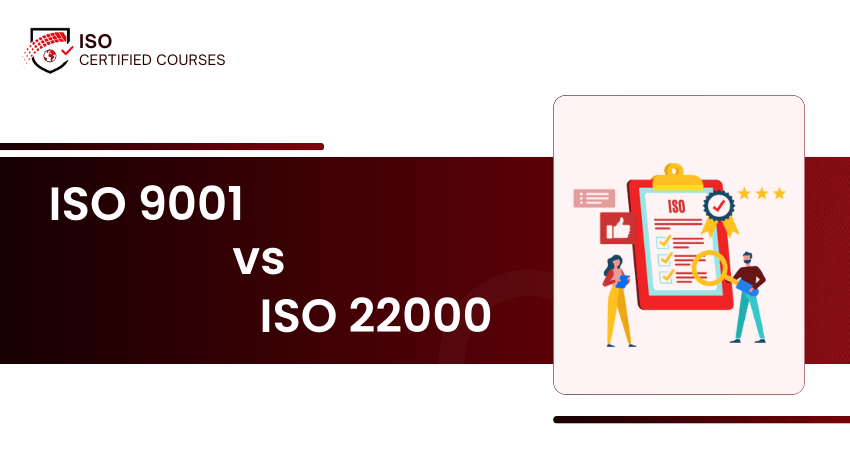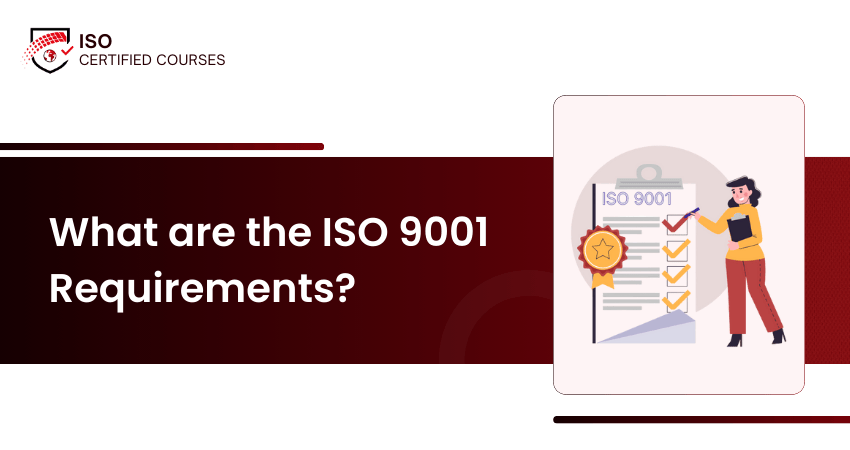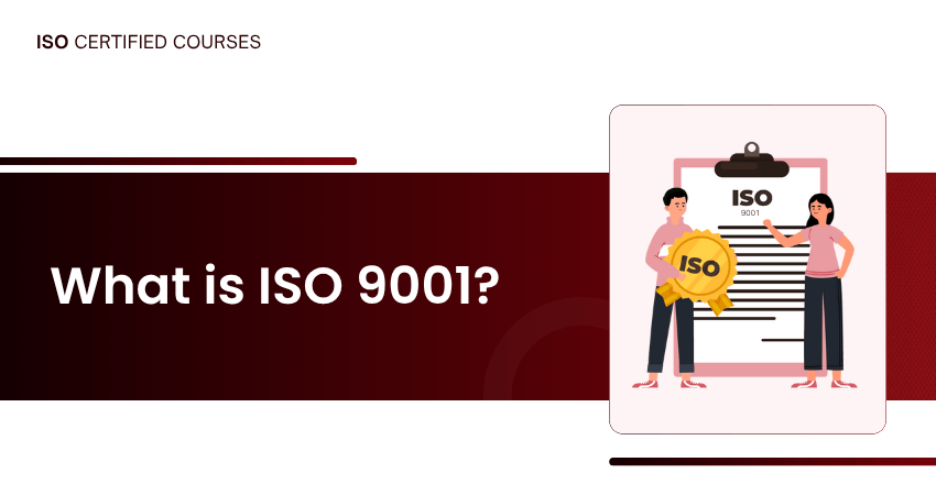
Great products and services don’t happen by accident; they’re built on systems that work. ISO 9001 is the world’s gold standard for developing those systems. It helps organisations identify gaps, improve processes, and deliver better outcomes for both customers and teams. It’s a commitment to doing things right - the first time, and every time.
In this blog, you’ll discover what is ISO 9001, why it matters, how to implement it, and how certification can elevate your brand. Ready to take control of your Quality Management System? Keep reading!
Table of Contents
What is ISO 9001?
Benefits of ISO 9001
What are the Core ISO 9001 Requirements?
How to Implement ISO 9001?
Steps to Achieve ISO 9001 Certification in Your Organisation?
Conclusion
What is ISO 9001?
ISO 9001 is the internationally recognised standard for Quality Management Systems (QMS), issued by the International Organization for Standardization (ISO). It captures a process-based approach for documenting and auditing the organisation, responsibilities, and procedures necessary to gain effective Quality Management.
The standard is based on seven quality management principles, including Customer Focus, Leadership, Engagement of People, Process Approach, Improvement, Evidence-Based Decision Making, and Relationship Management. It is applicable to organisations of any size, type, or industry, which makes it one of the most widely used management standards in the world.

Benefits of ISO 9001
Here are the benefits of ISO 9001:
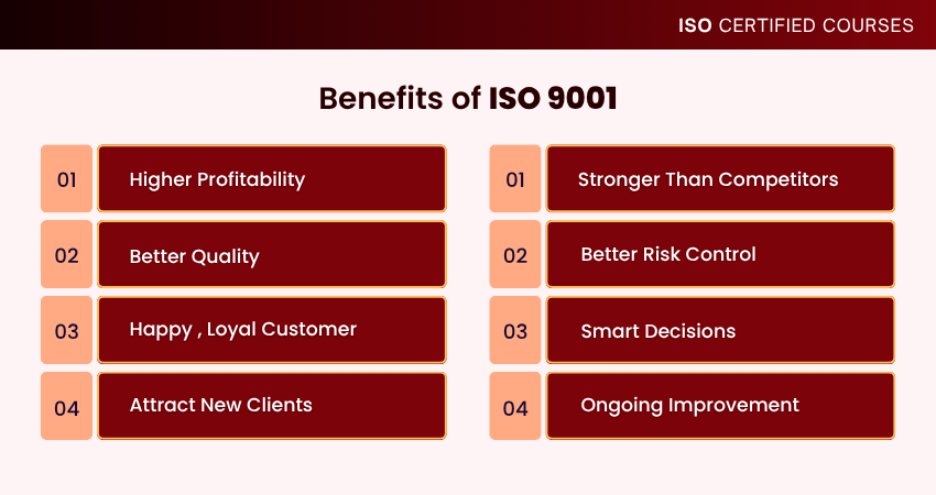
1) Higher Profitability: When processes are streamlined and well-defined, you reduce waste and inefficiencies. This results in cost savings and improved overall financial performance.
2) Enhanced Product and Service Quality: ISO 9001 sets clear process standards, leading to greater consistency and reliability in outputs.
3) Increased Customer Satisfaction: Meeting customer expectations consistently builds trust and fosters long-term loyalty.
4) Competitive Advantage: Organisations that apply ISO 9001 are seen as reliable. This can attract new clients who value quality and accountability.
5) Improved Success in Tendering: ISO 9001 implementation is often favoured in public and private sector tenders, making it easier to demonstrate your commitment to quality.
6) Stronger Market Position: Implementing ISO 9001 gives your business a verified framework, setting you apart from competitors who lack formal quality systems.
7) Greater Operational Efficiency: The standard helps identify inefficiencies, leading to more productive use of time, people, and resources.
8) Better Risk Management: ISO 9001 supports early identification and mitigation of potential issues, reducing costly disruptions.
9) Informed Decision-making: You’re encouraged to base decisions on evidence and analysis, leading to smarter, data-driven choices.
10) Regulatory Alignment: ISO 9001 helps ensure you understand and meet applicable laws and regulations, reducing the risk of non-compliance.
11) Engaged and Empowered Employees: Clear processes and roles increase employee confidence and purpose, boosting motivation and accountability.
12) Continual Improvement: The system encourages regular reviews and improvements, keeping you responsive to evolving customer and market needs.
13) Scalability and Growth: ISO 9001 supports business expansion by ensuring processes remain stable and controlled, even during major changes.
Start your quality journey today – Register for the ISO 9001 Foundation Course now!
What are the Core ISO 9001 Requirements?
The ISO 9001:2015 standard is structured into 10 clauses, each guiding organisations in building and maintaining an effective Quality Management System. The core requirements begin from Clause 4 through Clause 10, while Clauses 0-3 are introductory.
1) Clause 0: Introduction to the Standard
This section gives an overview of what ISO 9001 is all about. It explains how the standard is organised, how it focuses on step-by-step processes, and how it manages risks. This helps organisations keep improving to make customers happier.
2) Clause 1: Scope
Defines the purpose and applicability of ISO 9001. It confirms that the standard can be applied to any organisation aiming to enhance customer satisfaction by meeting quality and regulatory requirements.
3) Clause 2: Normative References
This clause lists documents referenced within the standard that are essential for its application. For ISO 9001:2015, the only normative reference is ISO 9000:2015, which provides fundamental QMS terms and definitions.
4) Clause 3: Terms and Definitions
This section explains key terms in ISO 9001 to ensure everyone interprets them consistently. It helps create a clear understanding of concepts like risk, customer satisfaction, and processes across industries.
5) Clause 4: Context of the Organisation
Requires organisations to understand their internal and external context, such as market trends, regulatory environments, or stakeholder expectations. These are to design a QMS that aligns with their strategic direction and business needs.
6) Clause 5: Leadership
This section explains that top management must show leadership by supporting the QMS. This includes setting the quality policy, defining roles, promoting customer focus, and ensuring resources are available.
You’ve mastered the basics, now learn to lead with our ISO 9001 Lead Auditor Course – Sign up now!
7) Clause 6: Planning
This strategy explains how organisations should identify and address risks and opportunities, set measurable quality objectives, and integrate these into overall strategic planning. It ensures alignment between QMS goals and business goals.
8) Clause 7: Support
This section covers the resources needed to run the QMS well, such as people, infrastructure, skilled staff, communication, and documentation. This ensures that the system is adequately supported at all levels.
9) Clause 8: Operational Controls
This section looks at all steps of operations, like planning, design, production, and delivery. It makes sure processes are controlled, changes are handled properly, customer needs are met, and results are checked before delivery.
10) Clause 9: Performance Evaluation
This section asks organisations to track and assess how well their QMS is working. This includes conducting internal audits, reviewing customer feedback, and using data to drive improvements.
11) Clause 10: Improvement
This section promotes ongoing improvement of the QMS by fixing problems, learning from data, and making changes. This clause ensures the system evolves to meet changing business and customer needs.
How to Implement ISO 9001?
To begin with ISO 9001, you need strong support from top management and a clear understanding of what your customers expect. Your first step will be creating a quality policy and objectives to understand how your quality system will work.
The next step can be writing down the important processes and procedures your business uses to make and deliver products or services. There are six required documents, and you can add more based on what your company needs. These documents can be made by your team or with help from a consultant or templates.
Once everything is in place, your team should use the system for a while. This helps collect proof that it works well. After that, carry out internal audits and management reviews to check how things are going. If you want official certification, you can then have a certification body audit your system.
Take the lead in building quality – Our ISO 9001 Lead Implementer Certification can be your first step!
Steps to Achieve ISO 9001 Certification in Your Organisation?
Getting ISO 9001 certified shows your commitment to quality and continuous improvement. Below are the key steps to help your organisation achieve ISO 9001 Certification successfully.
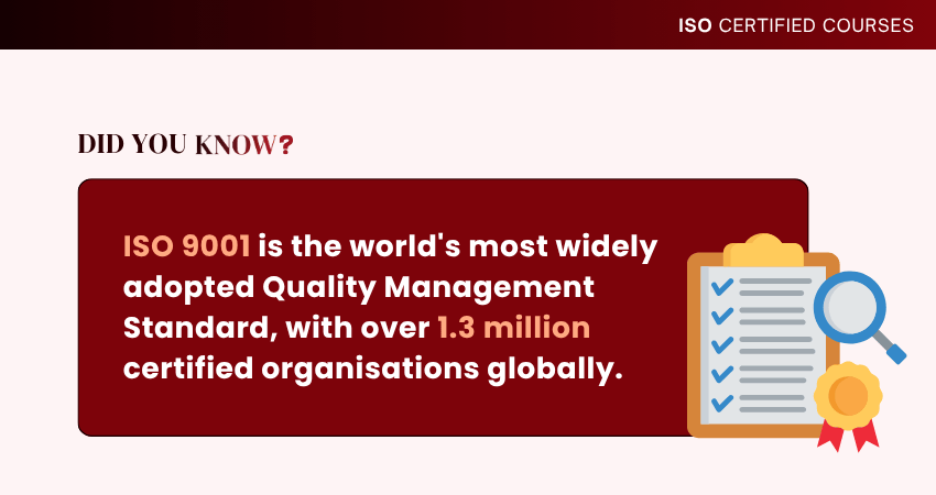
1) Understand ISO 9001 Requirements: Learn the standard structure, principles, and documentation needs.
2) Get Management Commitment: Ensure leadership supports the implementation and allocates resources.
3) Define Quality Policy and Objectives: Set clear goals and a quality mission aligned with business needs.
4) Determine Scope of the QMS: Decide which parts of your organisation will be included.
5) Conduct Gap Analysis: Compare current practices with ISO 9001 requirements to find gaps.
6) Create Documentation: Develop mandatory documents and other procedures that support your QMS.
7) Train Employees: Educate staff on their roles and the benefits of ISO 9001.
8) Implement the QMS: Put processes into action and maintain records.
9) Perform Internal Audits: Check if the system is working and find areas to improve.
10) Conduct Management Review: Review QMS performance and make strategic decisions.
11) Choose a Certification Body: Select an accredited body to conduct the external audit.
12) Undergo Certification Audit: The certifying body audits your QMS to verify compliance.
13) Achieve Certification: If successful, you’ll receive your ISO 9001 certificate, valid for three years, with yearly surveillance audits.
Conclusion
Understanding what is ISO 9001 is a strategic step for any organisation committed to quality, efficiency, and long-term success. It offers a proven framework to enhance customer satisfaction, improve operations, and build trust. By adopting its principles, businesses can strengthen their reputation and achieve consistent, measurable improvement across all areas.
Strengthen your career by joining our ISO 9001 Internal Auditor Training – Best of Luck!
Search Smarter
Quickly search through our blog content for what interests you


































